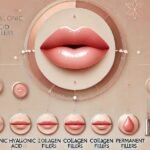People have always wanted to look beautiful. A fresh and youthful face boosts confidence, and many try different ways to keep their skin looking healthy. But as we age, fine lines, wrinkles, and loss of skin volume make us look older. This is why people look for ways to bring back their natural beauty and youthful glow.
In this blog, we will discuss what dermal fillers are, how they work, and the key terms related to this cosmetic treatment.
What are dermal fillers?
Dermal fillers are non-surgical cosmetic treatments that help enhance facial appearance. These gel-like injectables work by plumping the skin, restoring lost volume, smoothing fine lines, and creating a more youthful look. As we age, our skin loses elasticity and begins to sag. The American Society of Plastic Surgeons reports that dermal filler procedures were one of the most common cosmetic procedures, with over 2.6 million procedures carried out in 2023.
Dermal fillers, primarily made of hyaluronic acid—a substance naturally found in the body—help restore hydration and firmness. They are commonly used to:
- Add volume to the cheeks
- Smooth out wrinkles and fine lines
- Enhance lip shape and size
- Improve overall facial balance
- Rejuvenate aging hands
- Treat under-eye hollows for a refreshed look
Uses of dermal fillers
Collagen is a natural substance found in our body, but its production decreases over time. As collagen levels drop, the skin becomes loose and thin and loses its elasticity and volume, making signs of aging more visible. To restore lost beauty and firmness, skin fillers, such as dermal fillers, are used.
Uses:
Restore lost volume in the skin.
Reduce wrinkles and fine lines on the forehead and around the eyes.
Plump up lips and cheeks for a fuller and more balanced look.
Dermal fillers help maintain our lost beauty and youthful appearance by giving the face a fresher, more youthful, and well-defined look.
Types of dermal fillers
Dermal fillers include the following different types:
Hyaluronic acid:
Our body naturally produces hyaluronic acid. Hyaluronic acid binds the water molecules and keeps the skin hydrated. Its production decreases with age, causing dryness, volume loss, and the appearance of wrinkles. HA filler brands like Juvederm, Restylane, and Belotero are used to retain the volume and moisture. HA fillers last from 6 to 12 months depending on individual factors. Restylane is the most commonly used type of filler.
Calcium hydroxylapatite (CaHA)
Our bones produce the mineral calcium hydroxylapatite. CaHA is a vegan dermal filler that doesn’t containanimal products. It helps treat deeper wrinkles and skin folds. Its effects last between 12 and 18 months. A common brand of CaHA is Radiesse for long-term rejuvenation.
Poly-L-lactic acid (PLLA)
Poly-L-lactic acid (PLLA) is also known as a “stimulator” because it encourages the body to produce its collagen. People use it to reduce deep facial wrinkles and fill in tissue loss from wounds or sutures. The compound is a biodegradable substance, meaning it naturally dissolves in the body over time. Its effects can last for two years or more. The most well-known brand of PLLA fillers is Sculptra.
Polymethylmethacrylate (PMMA)
Polymethylmethacrylate (PMMA) fillers are semi-permanent fillers made of microspheres and collagen. They help treat deep wrinkles, skin folds, and acne scars while also adding volume to the face.
Upon injection, the collagen provides an immediate plumping effect, while the PMMA microspheres remain in the skin to offer long-term structural support. These fillers last significantly longer compared to other types, making them a preferred option for long-term facial rejuvenation. Bellafill is a popular brand of PMMA filler.
Autologous fat grafting
Autologous fat injections (fat grafting) are derived from the patient’s own body. The healthcare provider extracts excess fat from areas like the abdomen, thighs, or flanks using liposuction and then injects it into the face to restore volume. Since this procedure uses the body’s fat, it provides a natural and long-lasting solution for facial enhancement.
Comparison of Dermal Filler Types
Below is a comparison of different dermal fillers based on their composition, purpose, and longevity:
| Type of Filler | Main Component | Common Uses | Duration |
| Hyaluronic Acid (HA) | Hyaluronic Acid | Lips, cheeks, under-eyes | 6-12 months |
| Calcium Hydroxylapatite (CaHA) | Calcium-based microspheres | Deep wrinkles, facial contouring | 12-18 months |
| Poly-L-lactic Acid (PLLA) | Biodegradable synthetic polymer | Collagen stimulation, deep wrinkles | 2+ years |
| Polymethylmethacrylate (PMMA) | Microspheres & collagen | Long-term volume, acne scars | 5+ years |
| Autologous Fat Grafting | Patient’s own fat | Facial volume restoration | Permanent |
Example from Real Life: Restoring Facial Volume Loss
Sarah, a 45-year-old professional, observed growing nasolabial folds (smile lines) and hollowness in her cheeks. She decided to use HA fillers (Juvederm Voluma XC) to minimize wrinkles and restore cheek volume after speaking with a professional. Her face appeared more youthful and restored after half an hour. The outcomes had a little downtime and lasted for about a year.
Benefits of dermal fillers
Dermal fillers are non-surgical cosmetic treatments that help restore lost volume, smooth wrinkles, and fine lines, and improve facial symmetry. They enhance jawline definition, add volume to hollow areas, and contour the face for a more youthful look. Fillers are also used to plump thin lips and cheeks while providing a lifting effect. The procedure is quick, usually taking around 30 minutes, with minimal discomfort and little to no downtime. Most fillers provide instant results, while some work gradually by stimulating collagen production. Depending on the type of filler, dermal fillers before and after results can last for several months to over two years, making them a long-lasting and effective solution for facial rejuvenation.
Risks and Possible Side Effects
A common cosmetic procedure for enhancing facial features and regaining lost volume is dermal filler treatment. As with any medical operation, there are possible risks and adverse effects, even though they are generally regarded as safe. Before receiving treatment, it is crucial to comprehend these dangers.
Side Effects
The majority of adverse effects are minor and transient, usually going away in a few days. These could consist of:
- Bruising: The injection site becomes temporarily discolored.
- Redness: A slight skin irritation and inflammation.
- Swelling: Swelling is mild puffiness that subsides in a few days.
- Pain or tenderness: This type of discomfort is usually mild and goes away fast.
- Itching or Rash: Skin sensitivity or allergic reactions can cause itching or rash.
How does the procedure work?
Before getting dermal fillers Brisbane (or elsewhere), it is important to consult your healthcare provider. Discuss your goals and the areas you want to treat. Furthermore, tell them about your physical condition and any medications you are taking. The method typically entails the following, though there may be some minor variations based on the type of dermal filler you select:
Site preparation: Your provider will clean and sanitize the injection site on the day of the procedure. Additionally, they can mark your face where to inject the filler.
Anesthetic: By using a local anesthetic, anesthetic ointment, or a cold device to cool your skin, they may be able to relieve some of your discomfort. The procedure and your choices will determine the kind of anesthesia that is used.
Injection: A filler will be injected into the marked area. It should take less than a minute for each injection. If necessary, your physician may use a light massage to distribute the filler. To achieve the desired outcome, they may need to add more. The procedure could take from fifteen minutes to an hour, depending on how many spots you’re treating.
Healing: To lessen pain and swelling after the injections, your doctor may offer you a cool compress. After the operation, you can depart right away and resume your regular activities. Many patients recover without the need for medication, though there may be some soreness at the treatment site for a few days.
How long does dermal filler last?
Dermal fillers can last between 6 to 18 months. However, different factors decide how long do dermal fillers last. These factors include:
- Filler type: different fillers have different longevity, including hyaluronic acid (HA), calcium hydroxylapatite (CaHA), poly-L-lactic acid (PLLA), and polymethylmethacrylate (PMMA).
- Location of injection: Fillers in the lips and other more active facial regions typically degrade more quickly.
- Injection depth: Compared to other varieties, deep injections may last longer.
- Lifestyle: Excessive sun exposure and smoking can cause the breakdown of fillers.
- Skin thickness: The longevity of the fillers may be impacted by the thickness of your skin.
- Natural metabolism: The duration of the results may be impacted by how rapidly your body breaks down the filler.
- Dosage: The duration of the effects can be influenced by the quantity of filler injected.
Dermal fillers aren’t permanent. As the body breaks down the filler, it progressively disappears.
Aftercare Tips for Long-Lasting Results
Following the right aftercare instructions after receiving dermal fillers can help guarantee long-lasting results:
- To keep the filler from moving, do not touch or rub the treated area.
- Avoid alcohol and blood thinners (like aspirin or ibuprofen) to lower the risk of bruises.
- Use a cold compress instead of ice directly on the skin to help reduce pain and swelling.
- Avoid vigorous physical activities for at least 24 to 48 hours, as increased blood flow may hasten the breakdown of fillers.
- Avoid excessive sun exposure and stay away from heat sources like saunas and hot showers for 48 hours.
- Drink plenty of water and stay hydrated.
Final Thoughts
Are you thinking about dermal fillers? Speak with a qualified professional right now to learn more about your alternatives for looking younger and more radiant!
FAQs
Are dermal fillers painful?
A: Most patients have very little pain, particularly when numbing drugs are used before to treatment.
How quickly can I expect to see results?
A: Although results are frequently seen right away, the best results take a few days to appear when the swelling goes down.
Is it possible to reverse dermal fillers?
A: Hyaluronidase is an enzyme that can degrade HA fillers. Other fillers, such as PLLA or PMMA, cannot be reversed.
















